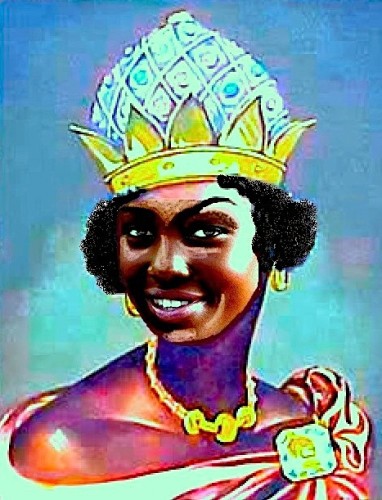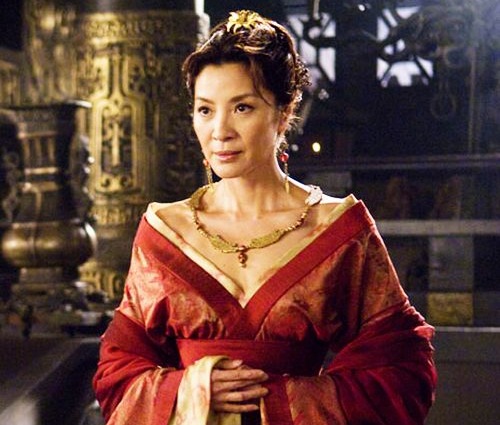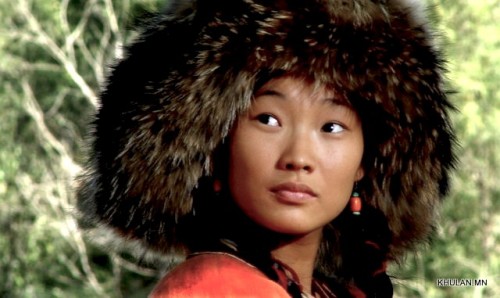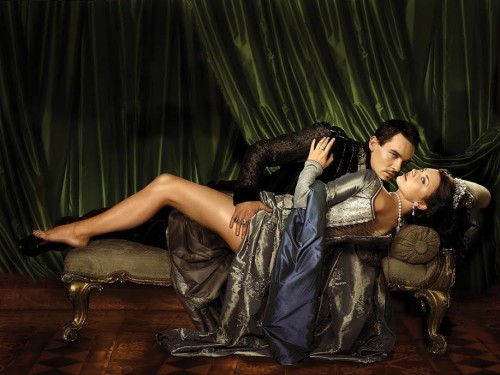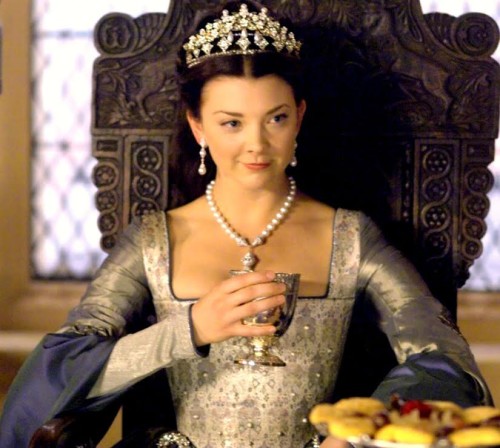
Damian Lewis smirks at me from a magazine rack under the caption “Damian Lewis Makes Henry VIII Sexy!” Déjà vu. Clearly, I’m missing the exciting difference between Wolf Hall‘s sinister-but-sexy Henry VIII and Eric Bana’s sinister-but-sexy Henry VIII in The Other Boleyn Girl, which rewrote Jonathan Rhys Meyers’ sinister-but-sexy Henry VIII in Fifty Shades of Tudors (OK, OK, Natalie Dormer did rock), which updated Richard Burton’s sinister-but-sexy Henry VIII in Anne of the Thousand Days, which critics agree was sexier than Charles Laughton’s Oscar-winning sinister-but-lovable Henry VIII in The Private Life of Henry VIII. It would be easy to make this a feminist issue, considering that chronic womanizer Henry VIII executed two wives for infidelity, despite having won the right to divorce them. However, 18 actresses have immortalized Queen Elizabeth I on screen, earning Oscar nominations for portraying the woman who presided over campaigns of religious persecution and expansive colonization as heroic, or sinister-but-lovable at worst.
Nowadays, we theoretically agree that colonialism was a bad idea. Our conquering heroes have become conquering antiheroes. Yet antiheroes actually command empathy as effectively as heroes. A study by Chippewa researcher JoEllen Shively found that 60 percent of her Sioux focus group, viewing Western The Searchers, identified with John Wayne’s viciously racist (and misogynist) Ethan Edwards. While conflicted, “half breed” sidekick Martin Pawley is cited as evidence that the film is “morally complex,” according to Shively, “the Indians, like the Anglos, identified with the characters that the narrative structure tells them to identify with.” Tokens represent no-one, only their author’s urge to appear liberal, while vicariously identifying with conquerors. Meanwhile, today’s White Saviors admirably rescue natives from evil colonizers, thereby ironically reinforcing the colonialist assumption that white heroes should control the destinies of the colonized.
Women of the Third and Fourth World are doubly marginalized; they are the damsels-in-distress for the natives-in-distress for the White Savior: #filmheranticolonialstory. Here in Ireland, our anticolonial icons remain unfilmed, apart from Irish director Neil Jordan’s Michael Collins, but entry to the EU Colonizer’s Club has entitled our Mr. Rhys Meyers to play colonial icon Henry VIII (progress!). So, while I would love to see Fiona Shaw as Pirate Queen Grace O’Malley, storming fortresses and sailing to London to confront Elizabeth I (thereby nailing the elusive Royal Bechdel), it matters more to invite audiences to identify with female leaders of the Third and Fourth Worlds. In honor of Henry’s wives and the #filmherstory campaign, here are six Royal women overdue the Hollywood treatment. To help with your visualizing, I’ll even toss in a pitch, director, and star.
Ava DuVernay’s Nzinga
The plot: Queen Nzinga Mbande fought and maneuvered in 17th century Angola. Serving as diplomatic envoy for her brother, Ndongo’s King, Nzinga personally negotiated a peace treaty with Portugal, sitting on a willing follower when denied an equal seat by their governor. Taking the throne in 1626, Nzinga forged alliances with African neighbors and Portugal’s Dutch rivals, scoring a victory against the Portuguese at the 1647 Battle of Kombi, and personally leading troops in battle until the age of 60. Building her base, Matamba, as a strategic trading port, the abolitionist Queen resisted the Atlantic slave trade and foreign rule throughout her lifetime, dying peacefully in 1663.
The pitch: Elizabeth: The Golden Age in Africa.
The star: Lupita Nyong’o is an internationally celebrated African star, noted for her regal style on the red carpet as well as her Oscar-winning acting. Playing an actual queen is the logical next step.
The director: Ava DuVernay’s Selma shows she can find interesting humanity in inspirational icons. In her hands, Nzinga could be a pragmatic political player, juggling conflicting alliances, more than a romantic ideal, and shed light on African colonial history from a fresh angle.
Ang Lee’s Cixi
The plot: Chinese historian Jung Chang‘s biography of Empress Dowager Cixi highlights her role in industrializing the country, opposing foreign rule, banning torture and foot-binding, educating women, establishing a free press and initiating China’s transition to parliamentary democracy. This semi-literate concubine forged a stable alliance with the Emperor’s wife (another Royal Bechdel), loved and lost a palace eunuch, whose execution was ordered by her own brother-in-law, faced down continual threats to her power and was driven by European encroachments to back the devastating Boxer rebellion. Not forgetting a Japanese invasion, a rebellious Emperor’s gay love affairs and Cixi’s final decision to prevent her reactionary adopted son from undoing her reforms by poisoning him. Drama!
The pitch: Crouching Tiger, Hidden Dragon meets The Last Emperor.
The star: Michelle Yeoh should be in everything. From her delicate portrait of repressed longing in Crouching Tiger, Hidden Dragon to her commanding turn in The Lady, Yeoh is the natural choice.
The director: With a heroine forced by convention to rule from behind a silk screen, this demands a director like Taiwan’s Ang Lee, who can make gripping drama out of restraint.
Deepa Mehta’s Lakshmibai
The plot: Though Rani (Queen) Lakshmibai was the heroine of India’s first technicolor epic, 1956’s Jhansi Ki Rani, she deserves Hollywood stardom and a grittier reboot. After her Maharajah husband died, Lakshmibai’s claim to rule, as regent for her adopted son, was denied by the British East India Company to justify their annexation of her state, Jhansi. Learning martial arts in childhood, Lakshmibai became a major leader of the 1857 Indian Rebellion, training women to fight in her ranks. Her role in a mutiny that massacred British forces at Jhansi’s fort remains unclear. Fighting off invasions by two neighboring rajas, her city finally fell to British heavy artillery. Lakshmibai fled in male disguise with her infant son, joined the rebel army of Tatya Tope and died fighting in the battle of Gwalior.
The pitch: Ashoka the Great meets Braveheart. For girls.
The star: Shriya Saran, who played Parvati in Mehta’s Midnight Children, showed the determination to prepare for her role by working for two months in Mumbai’s slums, and has an athletic body trained in Kathak and Rajasthani dance, with the striking beauty that even her British enemies admired in Lakshmibai.
The director: Deepa Mehta has tackled epic narratives of India’s Partition in Earth, taboo sexuality in Fire, the cruel treatment of widows in Water, and the diaspora experience in Heaven on Earth, but never explored British colonial rule. Like Sam Mendes directing Skyfall, putting Mehta in charge of an action epic could bring psychological depth to its high-octane clashes. Lakshmibai is so iconic in India that she is almost saintly, but Mehta has the guts to give her human flaws and delve into the brutal dilemmas of warfare.
Shonda Rhimes’ Ranavalona
The plot: “I will rule here, to the good fortune of my people and the glory of my name!” Ranavalona I has been labelled the “Mad Queen of Madagascar” for overseeing religious persecutions, inquisitions under torture and sweeping purges of political enemies, just like sinister-but-supposedly-sexily-sane Henry VIII. Rising from a commoner’s background, marrying the king and seizing absolute power on his death in a masterful coup, Ranavalona murdered the father of her child for his infidelity (*cough* Henry VIII), and harnessed French lover Jean Laborde to oversee Madagascar’s industrial revolution. Her later years were marked by excess, with numerous Malagasy dying to construct a road for her buffalo hunt, but Ranavalona foiled all plots to overthrow her (including ex-lover Laborde’s) and kept Madagascar free from colonial rule. There was method in her madness.
The pitch: The Tudors meets Shaka Zulu. For girls.
The star: Angela Bassett’s Emmy-nominated voodoo queen, Marie Laveau in American Horror Story: Coven, shows she can be commanding, scary and sympathetic in turn. Ranavalona is the role she was born for.
The showrunner: Ranavalona’s journey to the dark side deserves a Tudors-style series to fully develop. In Scandal and How To Get Away With Murder, Shonda Rhimes has proved that she relishes antiheroines and moral ambiguity. Ranavalona would take Rhimes into the lush historical epic, too long monopolized by white royalty.
Steve McQueen’s Nanye-hi
The plot: After snatching the rifle of her dead husband and rallying Cherokee warriors against their Creek rivals to win the 1755 Battle of Taliwa, Nanye-hi was elected Ghighau (Beloved Woman), heading the Women’s Council and sitting on the Council of Chiefs (OK, the Cherokee were too advanced to technically have royalty, cut me a break). Nanye-hi, also called “Nancy Ward” after marrying settler Bryant Ward, was a political moderate juggling extreme pressures, alerting settlers to Cherokee plans for a massacre, saving a white woman from burning at the stake and personally negotiating the peace treaty of 1781, but strongly opposing the sale of Cherokee lands and petitioning against plans for removal, which would culminate in the Trail of Tears after her death. Nanye-hi would showcase Indigenous traditions of “petticoat government” that inspired the first suffragettes, within a tense drama of compromise and resistance.
The pitch: Princess Kaiulani meets Borgen.
The star: If you’ve seen her powerful performance in Blackstone (lucky American readers can catch up on hulu), you know Michelle Thrush should be in everything that does not already star Michelle Yeoh (actually, I just had a great idea for a buddy cop movie). She’s a natural choice to capture the strain of Nanye-hi’s political conflicts.
The director: I haven’t yet seen Georgina Lightning’s Older Than America, so I can’t suggest any Native American women to direct. However, Steve McQueen’s treatment of the Irish Troubles in Hunger, and American slavery in 12 Years A Slave, prove the British director is unafraid to tackle controversial history with an outsider’s fresh eye. Lupita Nyong’o’s Oscar, for her first major film role, also shows his talent at coaxing raw performances from his actresses. Disney’s Pocahontas this would not be.
Timur Bekmambetov’s Khutulun
The plot: Mongols were pretty imperial, what with the largest land empire in history. But Central Asia’s absorption into the Russian/Soviet sphere has made it invisible, with Sacha Baron Cohen selecting Kazakhstan for Borat because “it was a country that no one had heard anything about” despite being the ninth largest in the world and launching the first man into space. Played by the physically slight Korean actress Claudia Kim, as a supporting character in Netflix’s Marco Polo, champion wrestler Khutulun deserves solo stardom. Excelling in battles against the armies of her cousin Kublai Khan, this Mongolian princess demanded that suitors beat her in wrestling, or forfeit 100 horses. She acquired 10,000 horses before making a politically strategic match of her own choosing. Nominated for khanship after her father’s death, Khutulun reportedly backed her brother Orus’ bid in exchange for being appointed Commander-in-Chief of his army.
The pitch: Mongol for girls.
The star: Mongol actress Khulan Chuluun was mostly stuck in the love interest role, but showed flashes of stubborn spirit. With a director like Bekmambetov, known for making action heroes of character actors like James McAvoy, could she train up and become an icon?
The director: Kazak director Bekmambetov’s talent for tongue-in-cheek, inventive action would be perfect for the unbelievable legends that have grown up around Khutulun. Witness his wild portrait of his namesake, Central Asian conqueror Tamerlane (Timur) in the opening of Day Watch. He’s also a great director of women, from Galina Tyunina’s scene-stealing Olga to Angelina Jolie’s tough-but-fair Fox in Wanted. Movie, please.
So, who would be your historical (anti)heroines? For the Soska Sisters to realize their dream to film Bathory? Michelle Rodriguez in Robert Rodriguez’s Malinche, as a punk survivor of sex trafficking who wants to watch the world burn? Gong Li as Zhang Yimou’s Wu Zetian? Kerry Washington in Fanta Régina Nacro’s Mama Yaa Asentewaa? Saoirse Ronan as a young Countess Markievicz for Juanita Wilson? Iman as Hatshepsut? Join the conversation – #filmherstory.
Brigit McCone writes and directs short films and radio dramas. Her hobbies include doodling and memorizing lists of forgotten female leaders (Brigit McCone is an extremely dull conversationalist).
